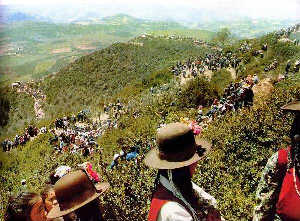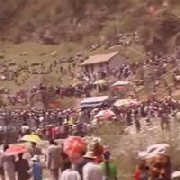Hua'er, literally meaning flower, is a unique form of folk song among the Hui, Han, Dongxiang, Sala, Bao'an, Tu, Tibet and Yugu ethnic groups mainly prevailing in Northwest China including Gansu and Qinghai provinces and Ningxia Hui andXinjiangUygur autonomous regions.
With a long history, rich content, various forms and exquisite melody, Hua'er boasts intense ethnic flavor and the uncouth style typical on the plateau. Deeply loved by local people, the art form is unique in Chinese folk songs and is a precious oral art form.
Qinghai is the hometown of Hua'er, and the art form is most popular in the Hehuang Region of the province's eastern part.
Most Hua'er works are love songs that also contain the hope and the pursuit of life. Hua'er prevails mostly in places of harsh living conditions. Facing the rigorous natural environment, people sing loud and sonorously with harmonious rhythms that can best express their heartfelt sentiments.
The Hua'er lyrics are simple, frank, fervent and ardent. A lot of the works directly describe the attachment and irresistible charm of loved ones, echoing the craving and perseverance for love. This might seem normal for pop songs nowadays, but for Hua'er, which is a traditional art form with a long history in China, it is quite out of the norm.
 Hua'er Meeting
Hua'er Meeting
Although Hua'er songs can often be heard almost anywhere at anytime in Qinghai, the most representative way of singing the songs with distinctive folk features is the famous "Hua'er Meeting," which is actually a carnival for the people in Hehuang. The meeting is a spontaneous activity that falls on the fifth and sixth month of theChinese lunar calendarand which can sometimes be attended by as many as hundreds of thousands.
 Although Hua'er songs can often be heard almost anywhere at anytime in Qinghai, the most representative way of singing the songs with distinctive folk features is the famous "Hua'er Meeting," which is actually a carnival for the people in Hehuang. The meeting is a spontaneous activity that falls on the fifth and sixth month of theChinese lunar calendarand which can sometimes be attended by as many as hundreds of thousands.
Although Hua'er songs can often be heard almost anywhere at anytime in Qinghai, the most representative way of singing the songs with distinctive folk features is the famous "Hua'er Meeting," which is actually a carnival for the people in Hehuang. The meeting is a spontaneous activity that falls on the fifth and sixth month of theChinese lunar calendarand which can sometimes be attended by as many as hundreds of thousands.
The meeting provides the people who had been working hard for most of the year an opportunity to relax themselves, and for the young, it's the time for courtship via their songs. This is also the best time of the year for Hua'er competitions, joint performances, and other communication programs. The meeting has in some way become a festival for the people of various ethnic groups, who wear their respective national costumes to attend the Hua'er gala during the plateau's most beautiful season.
Originally, "Hua'er Meeting" was a folk gathering related to temple fairs and sacrifices, when people would come to clusters of temples on sunny days to pray for good weather and safety for the family members and livestock. Meanwhile,people also took the chance to enjoy the landscape during the slack season in farming and communicate with each other. Besides the prayers and worships, the young people also began to tentatively communicate with each other by their songs.
sacrifices, when people would come to clusters of temples on sunny days to pray for good weather and safety for the family members and livestock. Meanwhile,people also took the chance to enjoy the landscape during the slack season in farming and communicate with each other. Besides the prayers and worships, the young people also began to tentatively communicate with each other by their songs.
In the course of time, singing Hua'er and courting for love became important parts of the temple fairs. Later, as Hua'er played a more and more important role, the gatherings' role as temple fairs faded. Finally, the original temple fair became the Hua'er Meeting.
